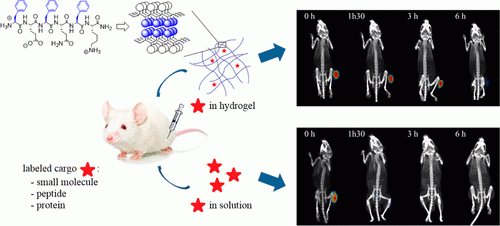
Hydrogels are promising materials for biomedical applications such as tissue engineering and controlled drug release. In the past two decades, the peptide hydrogel subclass has attracted an increasing level of interest from the scientific community because of its numerous advantages, such as biocompatibility, biodegradability, and, most importantly, injectability. Here, we report on a hydrogel consisting of the amphipathic hexapeptide H-FEFQFK-NH2, which has previously shown promising in vivo properties in terms of releasing morphine. In this study, the release of a small molecule, a peptide, and a protein cargo as representatives of the three major drug classes is directly visualized by in vivo fluorescence and nuclear imaging. In addition, the in vivo stability of the peptide hydrogel system is investigated through the use of a radiolabeled hydrogelator sequence. Although it is shown that the hydrogel remains present for several days, the largest decrease in volume takes place within the first 12 h of subcutaneous injection, which is also the time frame wherein the cargos are released. Compared to the situation in which the cargos are injected in solution, a prolonged release profile is observed up to 12 h, showing the potential of our hydrogel system as a scaffold for controlled drug delivery. Importantly, this study elucidates the release mechanism of the peptide hydrogel system that seems to be based on erosion of the hydrogel providing a generally applicable controlled release platform for small molecule, peptide, and protein drugs.
